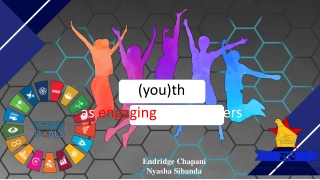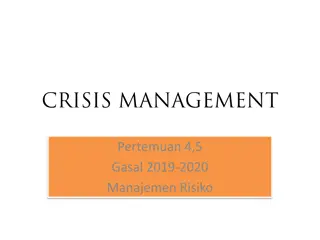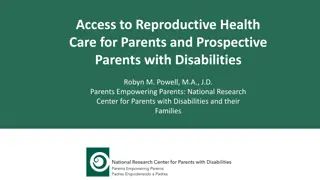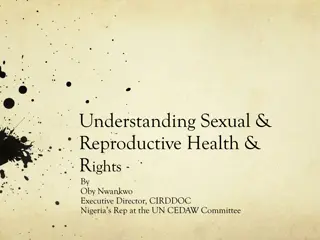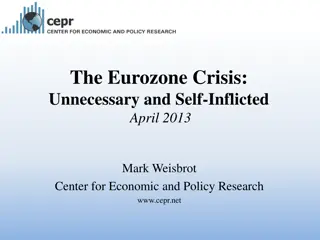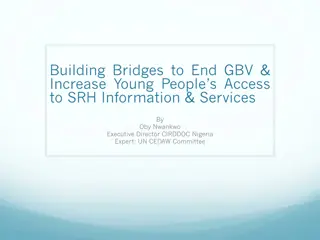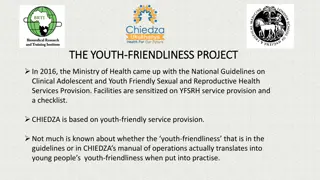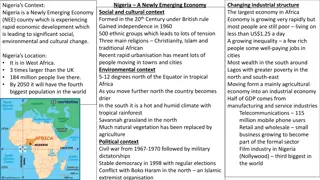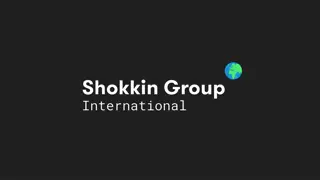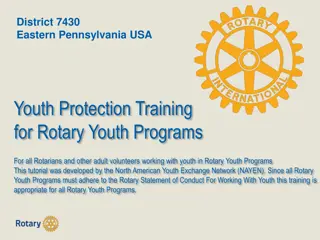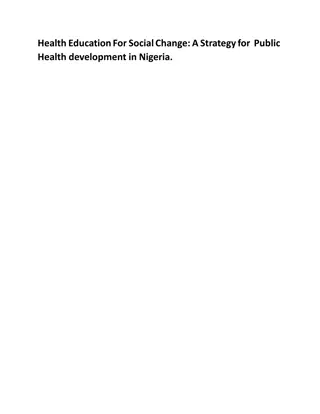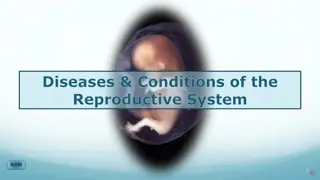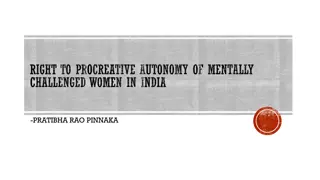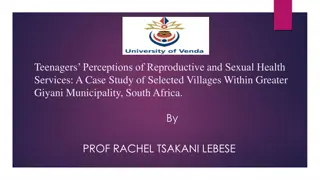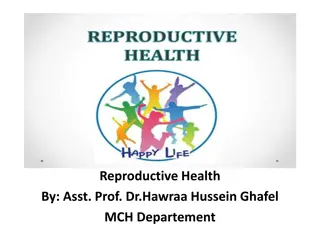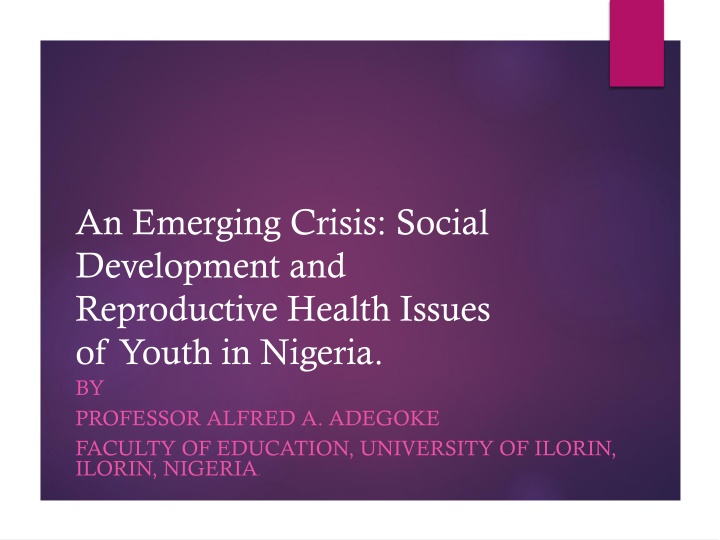
Emerging Crisis: Youth Reproductive Health in Nigeria
Addressing the critical social development and reproductive health challenges faced by youth in Nigeria, this presentation by Professor Alfred Adegoke delves into the global and national burdens of youth development, emphasizing the need for investment in youth sexual and reproductive health. The presentation explores key indicators, drivers, and implications of adolescent reproductive health issues, highlighting the importance of early intervention and education. It also provides insights into evidence-based approaches and essential steps for the way forward, emphasizing the significance of addressing youth reproductive health for national development.
Download Presentation

Please find below an Image/Link to download the presentation.
The content on the website is provided AS IS for your information and personal use only. It may not be sold, licensed, or shared on other websites without obtaining consent from the author. If you encounter any issues during the download, it is possible that the publisher has removed the file from their server.
You are allowed to download the files provided on this website for personal or commercial use, subject to the condition that they are used lawfully. All files are the property of their respective owners.
The content on the website is provided AS IS for your information and personal use only. It may not be sold, licensed, or shared on other websites without obtaining consent from the author.
E N D
Presentation Transcript
An Emerging Crisis: Social Development and Reproductive Health Issues of Youth in Nigeria. BY PROFESSOR ALFRED A. ADEGOKE FACULTY OF EDUCATION, UNIVERSITY OF ILORIN, ILORIN, NIGERIA.
Overview of Presentation Global and National Burden of YSD/RH Critical Indicators of Reproductive Sexual Health of Young People in Nigeria Drivers of Adolescent Reproductive Health in Nigeria
Overview of Presentation Global Evidence of Positive Impact SRH for Young People lessons for current program Nigerian Based Approaches to Address YSD/RH Why Investing in YSD/RH as a tool for National Development Essential Steps for the Way Forward/Recommendations
Overview of Global and National Burden of Youth Development and Reproductive Health Issues Young people worldwide are reaching puberty earlier and marrying later Premarital sex is becoming more widespread Many who become sexually active at an early age do not know how to protect themselves during sexual activity One third of the sexually transmitted infections (STIs) contracted each year globally are among women and men younger than 25 years of age
Overview of Global and National Burden of Youth Development and Reproductive Health Issues Contd. Having an untreated STI significantly increases the risk of HIV infection (UNFPA, 2004) In much of the world, millions of girls are still expected to marry and begin childbearing in their teens before they are emotionally and physically ready Births among women and girls under the age of 20 account for 17% of all births in least developed countries which translates into 14 million births worldwide each year
Overview of Global and National Burden of Youth Development and Reproductive Health Issues Contd. Pregnancy-related problems constitute a leading cause of death for young women aged 15 19 years with complications from childbirth and unsafe abortion representing the major contributing factors (UNFPA, 2004)
Overview of Global and National Burden of Youth Development and Reproductive Health Issues Contd. With close to 160 million people, Nigeria is the most populous country on the African continent The national maternal mortality rate is high, at 545 per 100,000 live births (NDHS, 2008) Life expectancy at birth is about 48 years Nigeria is a young nation Nearly one-third of its population is between 10 and 24 years of age
Critical Indicators of the Reproductive and Sexual Health of Young People in Nigeria (NDHS, 2008) 23% of women 15-19 years old had given birth or were pregnant with their first child The median age for first birth among women ages 25-49 was 20.4 Nearly half of Nigerian women were married by age 18; the median age of marriage among women aged 25-49 was 18.3 20% of women were sexually active by age 15
Critical Indicators of the Reproductive and Sexual Health of Young People in Nigeria (NDHS, 2008) contd. The median age at first intercourse was 17.7 for women and 20.6 for men More than 40% of sexually active, unmarried women were using a modern method of FP; the most common is condom (35%). 37% of young women knew a condom source, as do 68% of men aged 15-24 7% of young men and women had been tested for HIV and received their results within the 12 months before the survey
Critical Indicators of the Reproductive and Sexual Health of Young People in Nigeria (NDHS, 2008) contd. Teenage pregnancy varies from 45% in the North West to 8% in the South East Fifty-five percent of women with no education are likely to have had a child before age 20 but only 3% of those with secondary or higher education Among those in poorest households, 46% had a child before 20, compared to 5% in the wealthiest
Critical Indicators of the Reproductive and Sexual Health of Young People in Nigeria (NDHS, 2008) contd. Women in urban areas have their first births on average nearly three years later (mean age 22.3) than women in rural areas (mean age 19.5) The average of marriage among women in urban areas is 21.1 and in rural areas 16.9 The average age at first intercourse for women in urban areas is 19.2 and in rural areas is 16.5
Drivers of Adolescents Sexual and Reproductive Health Experiences Overwhelming poverty disposes adolescents to high- risk behaviours and pushes parents to e.g. marry off girls Socially prescribed gender roles undermine young women s agency and ability to protect themselves Common for girls to have sex with or get married/given in marriage to considerably older and sexually experienced men who offer resources/protection, but more likely to have HIV Boys have considerably more sexual partners compared with girls of the same age and rarely use condom
Global Evidence of Positive impact of SRPH for Youths Evidence on the effectiveness of various SRH programs for youths around the world has been growing for the past three decades A number of papers have been written to try to synthesize what is known about the different interventions (Kirby, 2006 a review of programs approaches for adolescent reproductive Health- Washington DC USAID
Global Evidence of Positive Impact of SRPH for Youths Lessons for current SRH Programs for Youths Young people are not a monolithic group no one size fits all There is no magic bullet approach multiple messages through multiple modalities needed Youth at-risk need access to integrated RH/HIV services Replace one-time efforts with sustained and comprehensive multiple interventions Ecological approach to working with schools and communities more profitable Young people should be fully involved in the design and implementation of interventions
Global Evidence of Positive impact of SRPH for Youths Lessons for current SRH Programs for Youths Addressing social and gender context in program design and messaging brings better result During implementation staffing and tailoring programs to meet the needs of population is very crucial Programs that have impacts on knowledge, beliefs, attitudes, and intentions do not necessarily have impact on behaviour When adolescents were asked characterized a youth- friendly clinic, they gave priority to confidentiality, short waiting time, low cost and friendly staff.
Nigerian Based Approaches to Address YSD/RH Enabling Environment The national policy environment is currently very favourable to providing YSD/RH given such polies as:- Health and Development of Adolescent and young People in Nigeria (FMOH) National Youth Policy (FMYD) National Policy on School Health (FMOE) A number of projects working with State Governments on adolescent health by USAID, UNFPA, DFID, World Bank, WHO, UNICEF etc.
Nigerian Based Approaches to Address YSD/RH Knowledge, Skills, Attitudes and Self-Efficacy- FLHE In-School Family Life and HIV Education the FLHE program is nationally approved and is being implemented in a number of public and private schools across the country. The curriculum is graded for age and educational level. The current partnership between the NYSC and UNICEF has great potential to promote the adoption of FLHE throughout Nigeria. The USAID-supported Northern Education Initiative project in Bauchi and Sokoto States is helping to promote FLHE
Strengths and Challenges of FLHE strengths The FLHE curriculum has been approved by the National Council on Education, the highest policy-making body in the educational sector The is evidence across the country that there is a broad buy-in to the FLHE program by all stakeholders Making the FLHE curriculum available electronically has increased the potential for making it more widely available
Strengths and Challenges of FLHE Challenges Effective FLHE implementation requires considerable resources, particularly for training teachers Effective monitoring and supervision is also very critical to success The program does not reach out-of-school adolescents
Nigerian Based Approaches to Address YSD/RH Knowledge, Skills, Attitudes and Self-Efficacy- IEC/Life Skills Program - Stand- alone ASRH IEC/Life Skills Program Stand-alone ASRH IEC/Life Skills Program these are NGO-operated programs that have no health- related services but are limited to educational interventions. Their core focus is building the knowledge and skills of young people An example is the program being implemented by girls Power Initiative (GPI) in Calabar. Another example is NAYAP in Lagos Strengths of this program is its dedication to young people Challenge Stand-alone IEC/Life-skills programs need a robust referral network to ensure that the needs of young people are targeted comprehensively
Nigerian Based Approaches to Address YSD/RH Knowledge, Skills, Attitudes and Self-Efficacy- IEC/Life Skills Program - IEC Integrated With Livelihood Skills IEC Integrated With Livelihood Skills these types of services provide SRH information alongside vocational training or livelihood Examples of program are those of Adolescent Health Information Project (AHIP) and FOMWAN in Bauchi and Kano. Others are those of (YEDA) Youth Environment Development Association and (AYDI) Adolescent Youth Initiative also based in Kano Strengths these program address economic and livelihood issues, and are responsive to the needs of special groups e.g. married adolescent girls Challenges the programs are cost-intensive
Nigerian Based Approaches to Address YSD/RH Knowledge, Skills, Attitudes and Self-Efficacy- IEC/Life Skills Program - IEC Integrated With Health Services These programs involve both IEC and health service delivery. They are often implemented as part of youth-friendly health services Examples in the Action Health Incorporated (AHI) in Lagos, Association of reproductive and Family Health (ARFH) in Ibadan, and Planned Parenthood Federation of Nigeria (PPFN) Strengths- because of the link to health services they have the potential to reach many more young people Challenges because of the medical personnel start- up can be very costly
Nigerian Based Approaches to Address YSD/RH Knowledge, Skills, Attitudes and Self-Efficacy- IEC/Life Skills Program Mass Media/ICT Programs in this category include entertaining- educative programs on television and radio. They have rich adolescent-related contents relating to HIV and sexual behaviour Because of the growing use of mobile phones particularly among urban-based adolescents, behaviour change messages are now being disseminated through phones. Examples include Society for Family Health (SFH) Zip-Up adolescent-focused sexual abstinence multimedia campaign, the ku saurara program in northern Nigeria Strengths mass media can reach large no of young
Nigerian Based Approaches to Address YSD/RH Knowledge, Skills, Attitudes and Self-Efficacy- IEC/Life Skills Program School Health Services. School Health Services are found within school facilities and are meant to provide some health services to school based populations. Existing School Health services can be strengthened and broadened to provide accurate ASRH information and counselling. School Health Services has the potential of reaching a large number of young people It can be cost effective because it operates within the school.
Why Investing in YSD/RH a tool for National Development The huge population of young people in Nigeria makes them central to the country s social, political and economic development. Youth in Nigeria constitute not only a formidable demographic force, but also make up the next generation of parents, workers and leaders. Nigeria s socio-economic development can be compromised by the sexual and reproductive health issues afflicting its youth if not checked. Lack of sexual health information and services make young people vulnerable to sexually transmitted infections (STIs) and unintended pregnancy
Why investing in YSD/RH a tool for National Development Contd. Greater maternal morbidity and mortality are consequences of early child bearing Adolescents aged 15-19 years are two times more likely to die during childbirth, those 14 years and younger are five times more likely Their well being, therefore, has implications not only for their own lives, but also for the societies they will build and maintain. Their ability to play these roles effectively depends on the support of their families, communities and on the commitment of
Why investing in YSD/RH a tool for National Development Contd. Meeting their needs is a major continuing public policy challenge which calls for constant re-thinking of policies, re- assessment of priorities, commitment of adequate financial resources, and effective implementation of programs. More efficient and equitable resource allocation and improved policy formulation and implementation can only be achieved with a better understanding of their needs
Essential Steps for the Way Forward/Recommendations Evidenced based advocacy urgently needed to launch action on multiple fronts supporting application at scale of tested and appropriate YSD/RH interventions in Nigeria Continued rigorous evaluation and sharing of lessons learnt so far about effective strategies so as to inform program at scale to improve the sexual and reproductive health of young people in Nigeria. Programming should be cognizant of and
Essential Steps for the Way Forward/Recommendations Federal and state Governments need to lead the way by making statutory annual budgetary allocations for relevant evidence- based YSD/SRH interventions in Nigeria Multi-disciplinary, public-private collaboration and coordination is required to facilitate greater synergy in YSD/RH programming Civil Society actors with substantial experience in work with adolescents, youths, gender issues etc. should be brought on
Essential Steps for the Way Forward/Recommendations Work with communities to sensitize parents, religious leaders, and other stake holders to increase support for YSD/RH Promote youth-friendly policies especially in Sates and LGAs Explore the use of youth social networks, mass media, and new technologies such as smart phones to reach young people with information to enable them make choices that will improve their SRH Offer strong, integrated services such as
Essential Steps for the Way Forward/Recommendations Build up the implementation of FLHE in public and private schools and NGOs by training teachers and providing materials Build up the ability of youth, especially those out of school, to adopt self-efficacy attitudes and livelihood skills Raise awareness of sexual and school violence and put in place confidential reporting mechanism and counselling services Ensure that programs reflect social, cultural
Thank You for Your Attention

